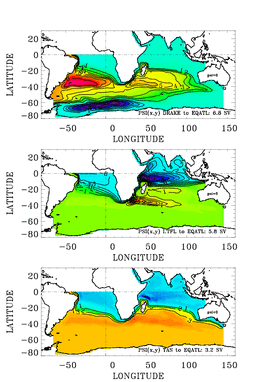|
DRAKE Path: 5.8 Sv of water coming from DRAKE reach the equatorial Atlantic section partly by circulating around (and recirculating within) the South Atlantic subtropical gyre, and partly by entering the Indian Ocean before coming back to the Atlantic basin via the Agulhas Current System (ACS). This is the materialization of the classical Cold Water Route first hypothesized by Rintoul (1991) with the variant that the structure of the route given by the model enhances the Indian-Atlantic connection proposed by Gordon et al. (1992) for the cold waters coming from DRAKE. ITFL Path : The Indonesian Throughflow water that does reaches the equatorial Atlantic crosses the entire Indian Basin westward before turning south and flowing essentially in the Mozambique Channel. Then, captured by the Indian subtropical gyre and the ACS the water is able to enter the Atlantic basin. Before flowing southward in the Mozambique Channel, part of the ITFL water takes a long journey in the Northern Indian Ocean. This path is clasically known as the Warm Water Route of Gordon (1986). Its intensity, 5.8 Sv, is of the same order of that of DRAKE.TAS Path : Water flowing westward just south of Tasmania and north of the ACC is able to cross the Indian Ocean, trapped in the northern boundary of the Indian subtropical gyre, and penetrates the Atlantic basin via the ACS. This origin has never been considered as a possible way for the ocean circulation to balance the thermohaline flow in the North Atlantic (Gordon, 1986; Broeker, 1991; Rintoul, 1991; Gordon et al., 1992; Schmitz, 1995, 1996a, 1996b). So this path represents a new route for the Upper Branch of the Conveyor Belt. With a contribution of 3.2 Sv, its input is not negligeable.
|
 Three Paths >>
Warm, Cold and Tepid Routes >>
Comparison with other GCMs >>
A17 Comparison
>>Conclusions
Three Paths >>
Warm, Cold and Tepid Routes >>
Comparison with other GCMs >>
A17 Comparison
>>Conclusions






